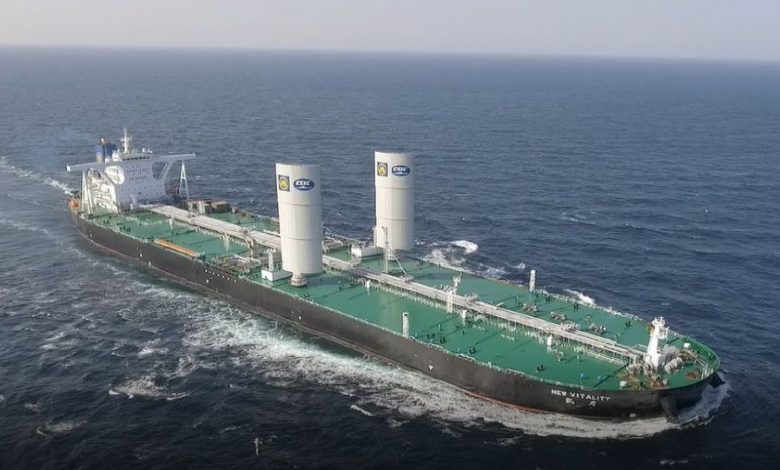Rigid sails for modern ships – it’s unlikely to be all plain sailing

Greg Atkinson from Japan’s Eco Marine Power on the growing interest in wind power among shipowners today.
Recently there has been a relative surge in interest within the shipping sector regarding the use of sail-assisted or wind-assisted propulsion devices. Examples of these devices or technologies include kites, soft sails, rotor sails and rigid sails – and all of them have been fitted to ships in the past. Indeed the past use of rigid sails on Japanese ships in the 1980’s yielded very encouraging results with fuel savings of up to 30% being reported. Yet today very few powered ships are fitted with these technologies. This is despite the potential benefits that their utilization could provide in terms of reducing fuel consumption and airborne emissions including CO2.
In regards to rigid sails in particular, their potential use has been of interest to me for some years and as part of my PhD research project at the Australian Maritime College, I investigated not only the benefits rigid sails could provide when utilized on large powered ships, but perhaps more importantly some of the disadvantages . The results from this study have now been published and a few of the more notable points from this paper are discussed below. As mentioned in the paper, a Strengths, Weaknesses, Opportunities and Threats (SWOT) analytical framework was used to identify key topic areas. This framework helped to broaden the scope of the areas covered in the study beyond design and engineering topics.
In terms of benefits or advantages the more obvious examples are a reduction in fuel costs and emissions. How sails work is no mystery, but of course they only work when there is wind. Therefore to what extent their use would reduce fuel consumption depends on the wind conditions along the route the ship is operating on. I know that’s a fairly obvious point but the apparent wind direction also impacts how well the sails will work. So very large sails on ships might at first appear like a good idea, but it has to be remembered that they essentially become cargo when the wind is not blowing. Other less obvious advantages include possible improvement in ship’s stability and the use of sails as an emergency propulsion system. There’s also the possibility that ships on specific routes could perhaps carry less fuel due to the fuel savings achieved. This in turn could reduce the overall weight of the ship and lead to further fuel consumption reductions.
The use of rigid sails could also help to improve the brand image (and consequently value) of the shipping companies that utilize them. Already many major shipping companies are actively promoting their efforts to operate in a more environmentally friendly way, as are an increasingly number of major equipment suppliers. It’s worth noting that a small survey included in the research paper indicated that most respondents would have a more favourable impression of a ferry or cruiseship company if their vessels used renewable energy.
Potential disadvantages identified during the study include the cost to install rigid sails onto existing ships or new-builds and the return on investment (ROI) period. Also operational issues both in terms of ongoing maintenance and the variability of their performance due to varying wind conditions need to be considered. The performance of the sails could also be significantly impacted if for example, the ship is moved from one route to another, especially if the wind conditions on the new route are not favourable to the use of sails.
Sails and associated equipment might also interfere with the loading and unloading of cargo, or potentially become a safety hazard due to a mechanical failure. For example if a 40 m high sail could not be lowered in a storm due to the malfunction of the stowing equipment, then this could be a major problem. In theory very large sails could provide a significant amount of propulsive force under favourable conditions, but just as in the golden age of sailing ships, large sails can also be a challenge to manage when things get rough.
There are also other fuel and/or emission reduction solutions available including air lubrication systems, scrubbers and LNG propulsion, plus some interesting technologies on the horizon with hydrogen fuel cells being of particular note. So there’s likely to be a mix of such technologies deployed especially on larger vessels. The Aquarius MRE (marine renewable energy) solution that we’re developing at Eco Marine Power for example combines rigid sails, photovoltaic (PV) panels and energy storage modules all into one computer-managed system.
So as regulations, policy measures and market pressures drive shipping away from the use of fossil fuels – rigid sails and similar devices are likely to be increasingly used and incorporated in new ship designs ranging from cargo ships, tankers and roro vessels to large passenger ferries and cruise ships. But it’s vitally important not to ignore any potential problems regarding their use or be overly eager to dismiss the concerns of ship owners. Because during the noble effort to make shipping cleaner, we need to also ensure we don’t stifle debate and discussion. Just because a technology is tagged as being ‘green’ shouldn’t mean its use cannot be questioned. Otherwise the solutions that are implemented to reduce fuel consumption and reduce vessel emissions may end up causing more problems than they solve, or may not be as effective as expected.

Thank you for your very objective and comprehensive thoughts and professional interpretation towards today’s zeitgeist.
Thank you PeterB. I think we need to be wary of tagging something ” green” and then thinking that’s the end of the discussion. By the way the full paper: “Considerations regarding the use of rigid sails on modern powered ships” is available via this link: https://www.cogentoa.com/article/10.1080/23311916.2018.1543564